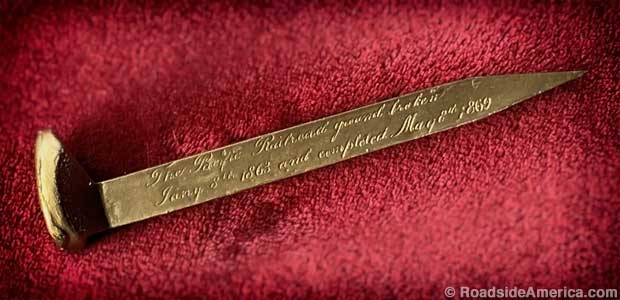
Golden Spike gift shop replica is plated in 22k gold. The real Spike ended up in California.
Transcontinental Railroad: The Golden Spike
Promontory Summit, Utah
The purpose of the Transcontinental Railroad was to link populated places in the East with populated places in the West, and eventually fill up a lot of relatively empty spaces in between, regardless of indigenous occupants. When the tracks from the East and West met at a remote spot named Promontory Summit on May 10, 1869, a small crowd gathered, a few photos were taken, and the famous "Golden Spike" was dropped into a pre-drilled hole in the last railroad tie. Then everyone went home.
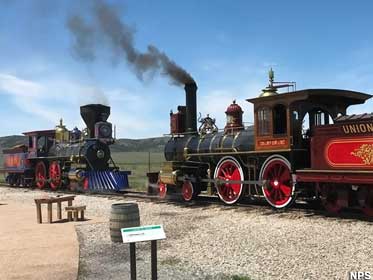
Locomotives with nowhere to go at Golden Spike National Historical Park.
(The rails actually met on May 8th 1869, the date engraved into the Spike, but the ceremony didn't join them until May 10; one of the dignitaries was delayed two days by rail workers demanding their back pay.)
For the next hundred years the Golden Spike site, despite its revered place in U.S. history, was essentially abandoned. By 1943 even the train tracks were gone -- torn up for their useful steel during World War II.
In the late 1950s a tourist attraction, the Golden Spike Railroad Museum, opened many miles away from the Spike site, but close to the nearest highway. Tourists could pose with full-size plywood replicas of the two famous Golden Spike locomotives. Few people bothered to drive the dirt road out to the Spike site. Aside from a single, squat, cement monument, there was nothing to see except sagebrush.
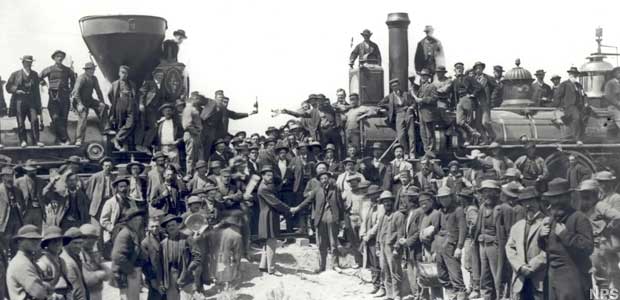
Connecting East and West: May 10, 1869.
In 1969, the government was finally shamed into paving the road and opening a Visitor Center at the site. Ten years after that, a short section of track was returned to the original rail bed and two old-fashioned steam locomotives arrived.
Since that brief burst of energy, the Golden Spike National Historical Park has resumed its sleepy isolation. "We're 32 miles from the nearest sizable town," said Supervisory Park Ranger Julie Blanchard -- and the National Park Service cautions tourists to fill their tanks: it's a 55 mile round-trip between the last gas station and the Spike site. "Visitors seem surprised how far out there we are," she said.
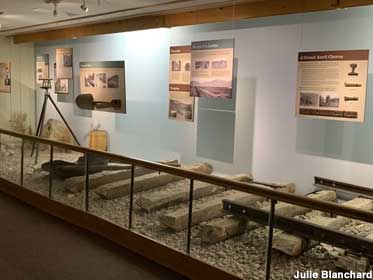
Visitor Center display of tracks and tools.
Symbolic accessories were part of the "Wedding of the Rails" ceremony in 1869, including not one, but two gold spikes, a sliver spike, a gold-and-silver spike, a sliver sledgehammer, and a special "Last Tie." They shared a moment of glory on that one afternoon, then they were immediately whisked away, back to civilization. Some found their way into New York and California museums, others were lost to fires and earthquakes, and the Golden Spike itself had parts carved off and fashioned into tiny spike watch fobs for wealthy railroad men (The Visitor Center displays one, framed on a wall). Meanwhile, the Transcontinental Railroad was completed with normal spikes, lumber, and sledgehammers.
A glass case in the Visitor Center displays a "Golden Spike," but not the famous one; it's a replica that flew on the Space Shuttle in 1990 (Visitors can purchase similar replicas in the gift shop). "Honestly," said Julie of the real Golden Spike, "we don't want it here. It would take a lot for our small visitor center to make sure it was protected. Having a replica is just fine with us."
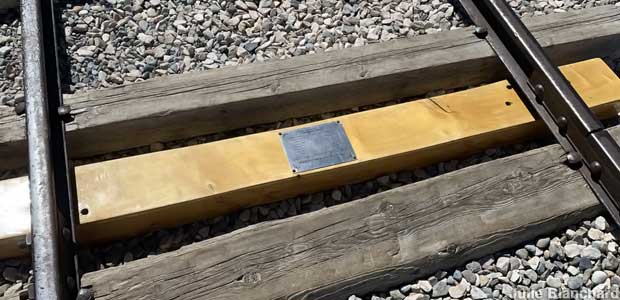
Replica Last Tie. The real one burned up over 100 years ago.
The plywood locomotives were demolished after the real ones arrived in 1979, although even the real ones are modern replicas; the original 1869 engines were sold for scrap during the site's long years of obscurity. "Some people come here thinking we actually have a rideable train," said Julie, but it's just the two locomotives and their tenders; rides aren't permitted, and there's nowhere to go anyway. From May 1 to mid-October the engines chug out of their shed every morning at 10:30, take up their famous positions, then chug back indoors at four. On summer Saturdays, costumed volunteers reenact the Last Spike ceremony at around 12:47, the time that the real ceremony concluded.
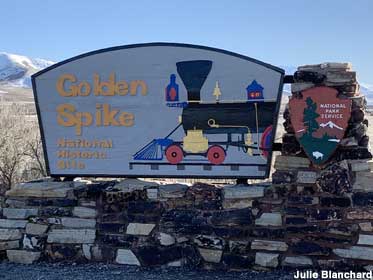
The flag-topped pole you see in the center of every tourist photo of the Golden Spike site is another replica: the hallowed Terminal Pole, whose telegraph wires alerted the world that the Golden Spike ceremony had taken place. If you arrive off-season, the site is still open -- every day -- although there's not much to see outdoors except for a replica of the Last Tie (and the pole). You can visit the engines in their shed, and the exhibits in the Visitor Center, and tourists sometimes lay across the empty tracks for gag photos, like silent movie damsels in distress.
And what of the whispers that Promontory Summit wasn't the site of America's first Transcontinental Railroad? Julie acknowledged that visitors sometimes raise that awkward subject, but "it doesn't come up very often."
Although the Golden Spike National Historical Park is a must-see destination for railroad and history buffs, it's still an out-of-the-way and empty place, a destination you really have to want to visit.
The National Park Service warns visitors of "unique weather-related inconveniences" at the site, as well as "high winds, insects, heat, cold, and encounters with wildlife." And the small parking lot -- only a few dozen spaces -- suggests that tourist demand is rarely overwhelming. If you arrive during one of those summer Saturday Golden Spike reenactments, you'll probably get a good seat.





